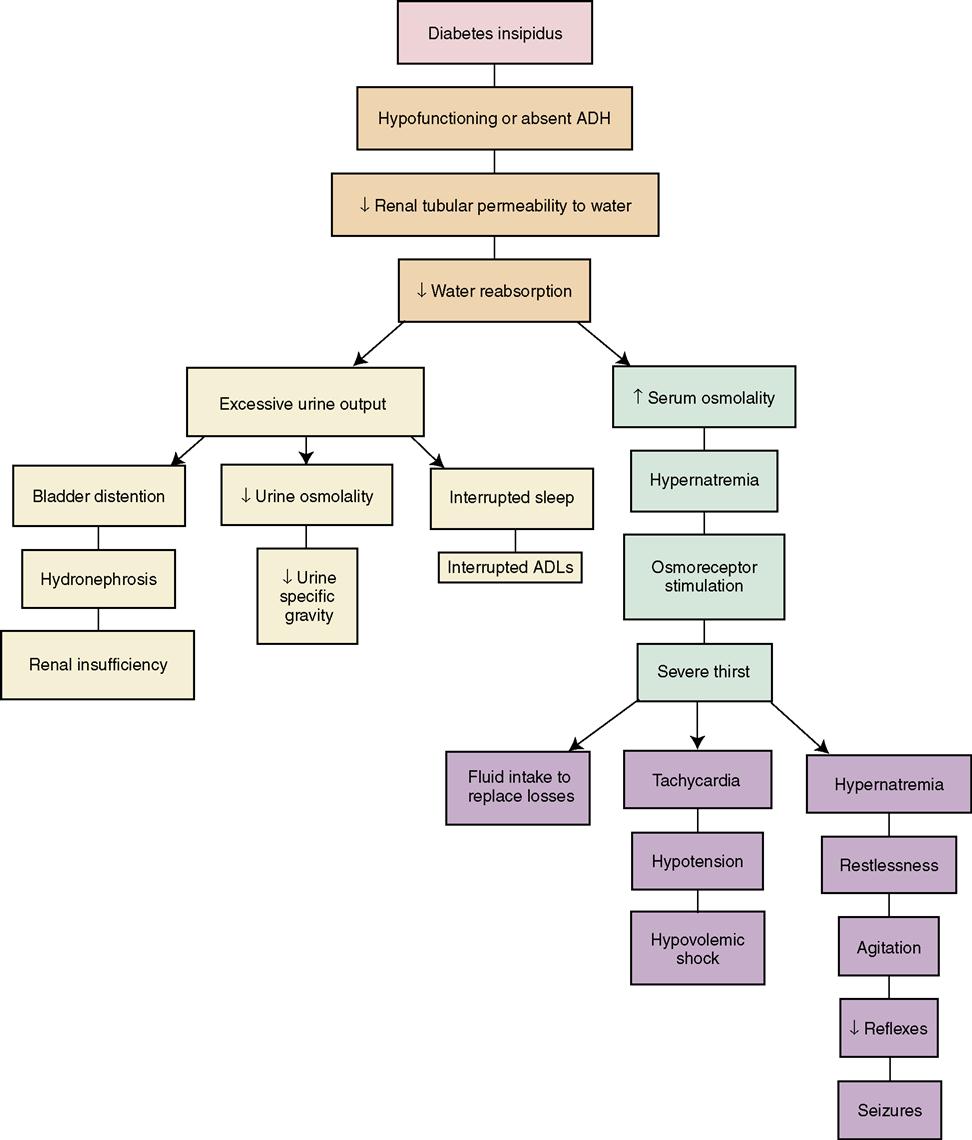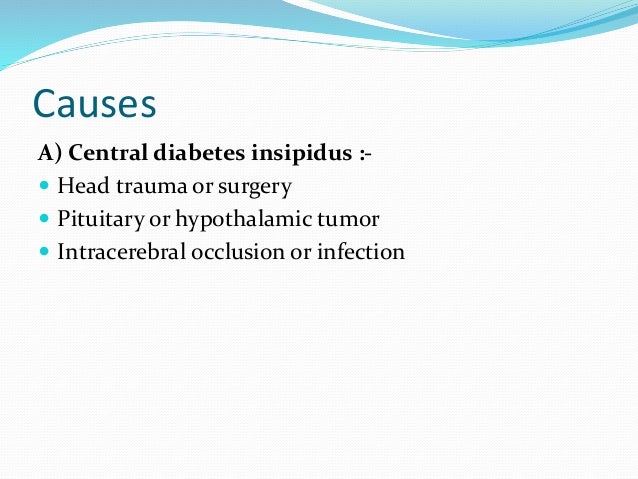Diabetes Insipidus Brain Tumor


Causes of diabetes insipidus: diabetes insipidus can be caused by several conditions, including the following: malfunctioning hypothalamus; damage to hypothalamus or pituitary gland during surgery; brain injury; tumor; tuberculosis; blockage in the arteries leading to the brain; encephalitis; meningitis. Central diabetes insipidus has several causes, including a brain tumor, a brain injury, brain surgery, tuberculosis, and some forms of other diseases. the main symptoms are excessive thirst and excessive urine production.
Central diabetes insipidus. damage to the pituitary gland or hypothalamus from surgery, a tumor, a head injury or an illness can cause central diabetes insipidus by affecting the usual production, storage and release of adh. an inherited genetic disease can also cause this condition. nephrogenic diabetes insipidus. Diabetesinsipidus should be taken into consideration as a hallmark of mp, which is a rare complication of benign tumor of the pituitary gland and it occurs in approximately 1% of adenomas. in these cases, it is a late manifestation of the adenoma lesion. diabetes insipidus in symptomatic patients with mp is calculated as 60–70% [4, 9. Diabetes insipidus can be caused by several conditions, including the following: malfunctioning hypothalamus damage to hypothalamus or pituitary gland during surgery brain injury tumor tuberculosis blockage in the arteries leading to the brain encephalitis meningitis sarcoidosis (a rare inflammation. Diabetes insipidus should be taken into consideration as a hallmark of mp, which is a rare complication of benign tumor of the pituitary gland and it occurs in approximately 1% of adenomas. in these cases, it is a late manifestation of the adenoma lesion. diabetes insipidus in symptomatic patients with mp is calculated as 60–70% [4, 9].
Pituitary Tumor Complications Endocrineweb
Diabetesinsipidus (di) is the deficiency diabetes insipidus brain tumor or resistance to the hormone vasopressin (antidiuretic hormone), which results in polyuria and polydipsia. epidemiology di occurs in 3 per 100,000 people 2. pathology di may be described as 1-3: ce. Cranial diabetes insipidus. the 3 most common causes of cranial diabetes insipidus are: a brain tumour that damages the hypothalamus or pituitary gland ; a severe head injury that damages the hypothalamus or pituitary gland ; complications that occur during brain or pituitary surgery ; no cause can be found for about a third of all cases of. Diabetesinsipidus is a rare type of disease that makes you lose too much water through your pee. specifically damage to the part of the brain that makes vasopressin or tumor, or for other.
Diabetesinsipidus Radiology Reference Article
Central diabetes insipidus has several causes, including a brain tumor, a brain injury, brain surgery, tuberculosis, and some forms of other diseases. the main symptoms are excessive thirst and excessive urine production. the diagnosis is based on urine tests, blood tests, and a water deprivation test. Central diabetes insipidus is a form of di that occurs when the body has a lower than normal amount of antidiuretic hormone (adh). adh is also called vasopressin. adh is produced in a part of the brain called the hypothalamus. adh is then stored and released from the pituitary gland. this is a small gland at the base of the brain. Diabetesinsipidus can happen because of kidney problems or an issue in the brain from surgery, a tumor, infection, or a head injury. pregnancy. mothers-to-be can get gestational diabetes insipidus.
Central diabetes insipidus can also be caused by trauma to the brain or a tumor in the brain or pituitary gland. nephrogenic canine diabetes insipidus can arise due to metabolic disorders, trauma to the kidney, kidney disease or it may be related to the administration of certain drugs. Diabetesinsipidus can be a component of panhypopituitarism in patients with brain tumor, brain trauma, and diabetes insipidus brain tumor infiltrating granulomatous diseases. diabetes insipidus in a catastrophically injured patient may be one of the first signs of brain death. diagnosis of diabetes insipidus is based on the presence of polyuria associated with hypernatremia. Diabetesinsipidus: symptoms. patients with diabetesinsipidus typically experience: excessive thirst, particularly for ice cold water; excessive urination of dilute urine ; if the brain's thirst mechanism is working normally, a person with diabetes insipidus will drink large volumes of water to maintain a normal serum concentration. Diabetesinsipidus (di) is defined as the passage of large volumes (>3 l/24 hr) of dilute urine (< 300 mosm/kg). it has the following 2 major forms: central (neurogenic, pituitary, or neurohypophyseal) di, characterized by decreased secretion of antidiuretic hormone (adh; also referred to as arginine vasopressin [avp]) nephrogenic di, charac.
The reduced level of adh may be caused by damage to the hypothalamus or pituitary gland. this damage may be due to surgery, infection, inflammation, tumor, or injury to the brain. in rare cases, central diabetes insipidus is caused by a genetic problem. click to keep reading. Central diabetes insipidus happens when damage to a person's hypothalamus or pituitary gland causes disruptions in the normal production, storage, and release of vasopressin. the disruption of vasopressin causes the kidneys to remove too much fluid from the body, leading to an increase in urination. More diabetes insipidus brain tumor images.
There are many causes of central (pituitary) diabetes insipidus, including: congenital absence of the gland lesions that involve or destroy the pituitary stalk and/or posterior pituitary gland craniopharyngioma lymphocytic craniopharyngioma lymphocytic hypophysitis sarcoid germinoma rathke's. A brain tumor at or near the hypothalamus may cause these bothersome symptoms, as can a tumor that occurs on the pituitary gland. certain types of cranial diabetes insipidus are known to be genetic in nature, while condictions that affect the entire body, such as sarcoidosis, may also create bothersome symptoms. Diabetes insipidus is a different disease from diabetes mellitus. their names are similar, but the only things they have in common is that they make you thirsty and make you pee a lot.
An infant or young child with diabetes insipidus may have the following signs and symptoms: heavy, wet diapers bed-wetting trouble sleeping fever vomiting constipation delayed growth weight loss. Diabetesinsipidus: this type of diabetes—not to be confused with type 1 or type 2 diabetes, which causes an increase in your blood glucose level—is mostly associated with larger pituitary tumors (called macroadenomas). diabetes insipidus happens when your pituitary gland and the gland found just above it, the hypothalamus, don't produce enough vasopressin, a hormone that's in charge of. Diabetesinsipidus is a rare disorder that occurs when a person's kidneys pass an abnormally diabetes insipidus brain tumor large volume of urine that is insipid—dilute and odorless. in most people, the kidneys pass about 1 to 2 quarts of urine a day. in people with diabetes insipidus, the kidneys can pass 3 to 20 quarts of urine a day. Diabetes insipidus can be a component of panhypopituitarism in patients with brain tumor, brain trauma, and infiltrating granulomatous diseases. diabetes insipidus in a catastrophically injured patient may be one of the first signs of brain death.
Diabetesinsipidus following resection of pituitary tumors. schreckinger m(1), szerlip n, mittal s. author information: (1)department of neurosurgery, wayne state university and detroit medical center, detroit, mi 48201, usa. diabetes insipidus (di) is a common complication following pituitary surgery and can be transient or permanent. Treatment options for the most common types of diabetes insipidus include: central diabetes insipidus. if you have mild diabetes insipidus, you may only need to increase your water intake. if the condition is caused by an abnormality in the pituitary gland or hypothalamus (such as a tumor), your doctor will first treat the abnormality. A 54-year old man was admitted with extensive disease: small cell lung cancer, and severe central diabetes insipidus. computer assisted tomography of the brain was negative for metastatic spread to the hypothalamus or pituitary gland. basic levels of antidiuretic hormone were within normal limits, yet the hormone failed diabetes insipidus brain tumor to increase secondary to elevated osmotic load.
Comments
Post a Comment